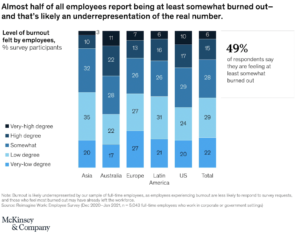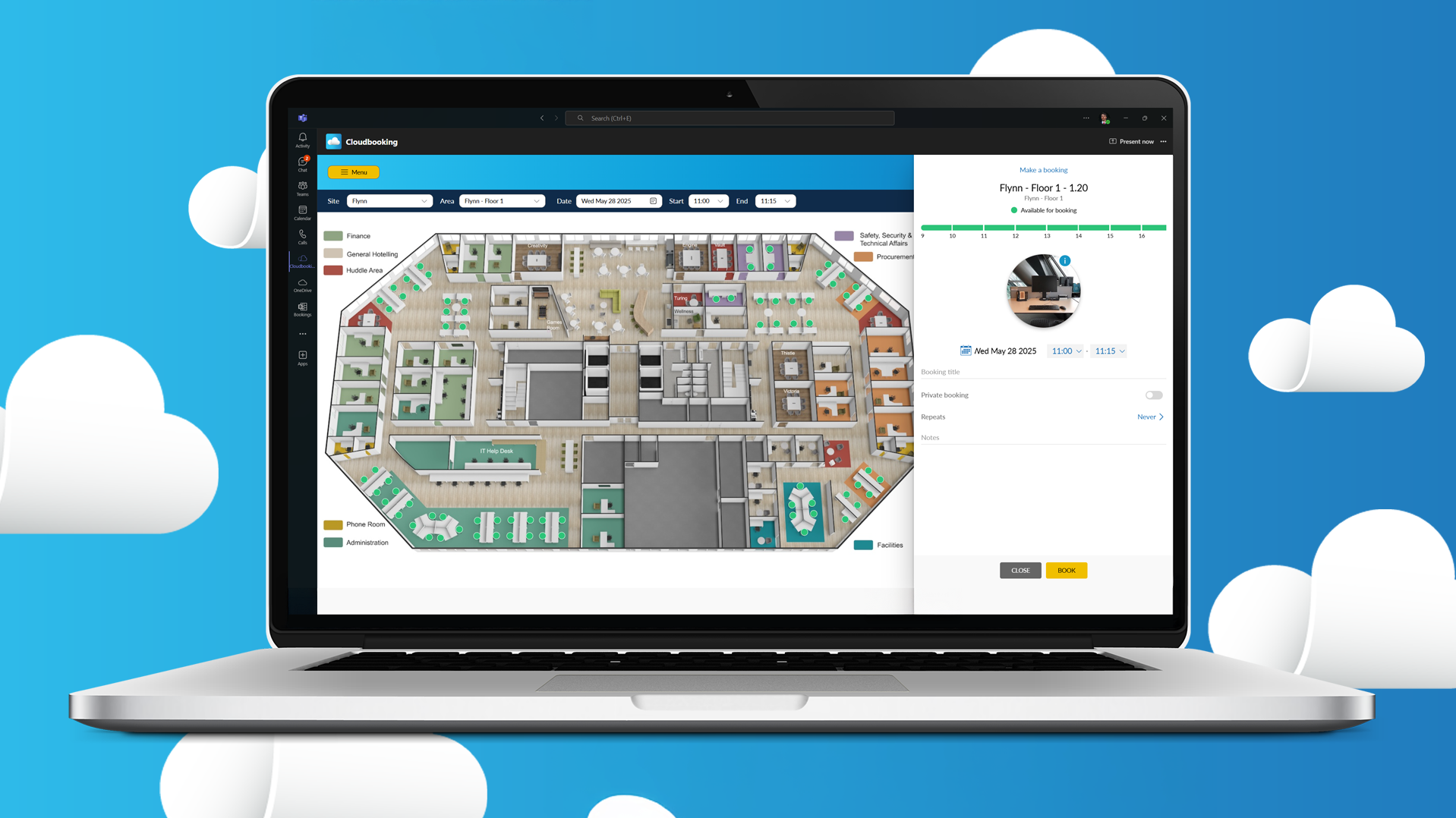
Burnout is a state of physical, mental, and emotional exhaustion caused by prolonged or chronic stress. It’s no secret that employee burnout is a huge problem in the workplace. But why exactly does it happen? More importantly, how can employers prevent their people from burning out?
Picture this scenario: Susie, one of your best employees, has been on a roll over the past year and a half, meeting monthly targets and even volunteering to help out others on your team.
But out of the blue, her productivity drops. Susie begins showing up late to work. You brush it off — everyone has bad days, right? But over the next few weeks, she calls in sick multiple times. On the days she’s in the office, you notice she’s no longer as engaged as before. The next thing you know, Susie’s handed in her notice.
You didn’t know it at first, but Susie showed all the classic signs of poor engagement and employee burnout. You only managed to put two and two together after realising she hadn’t taken a real break from work over the past two years.
Related Reading: How to Build Employee Engagement, Satisfaction, and Increase Staff Retention
Is employee burnout on the rise?
Employee burnout is not a new phenomenon. As a concept in the workplace, “burnout” dates back to the 1970s, when American psychologist Herbert Freudenberger used the term to describe the impact of severe stress and exhaustion in “helping professions” — doctors and nurses who, in the process of putting others first, ended up “burned out.”
However, the past two years saw arguably the biggest spike in employee burnout in the 21st century. Between the COVID-19 pandemic, the ongoing economic crisis and the Russia-Ukraine conflict, the beginning of the decade saw workers pushed to the limits of their mental health and overall well-being.
The Washington Post reports that burnout was one of the main reasons record numbers of people left their jobs in 2021 — a period that came to be known as the Great Resignation. Those who stayed, on the other hand, also experienced their own burnout as they were left to pick up the slack.
Related Reading: Building an Employee Engagement Strategy for 2022
Meanwhile, a study by McKinsey & Company reveals nearly half of the employees they surveyed in 2021 report feeling some symptoms of being burned out. However, McKinsey notes these results may underestimate the severity of the problem, as people experiencing exhaustion and burnout are less likely to participate in surveys. Not to mention, the most burned-out workers — women, in particular, were disproportionately affected — may have long left the workforce.
Source: McKinsey & Company
Again, employee burnout is not new. But employers need to recognise that we’re living in unusual times and more needs to be done to catch the signs of burnout and take action to prevent things from getting worse.
In this Cloudbooking guide, we go over the signs of employee burnout, the risk factors behind this workplace phenomenon and the steps employers can take to prevent burnout from impacting their people and organisation.
What is employee burnout?
Employee burnout is a state of physical, emotional, and mental exhaustion brought on by chronic workplace stress. When employees are in a state of burnout, they may feel like they’re constantly running on empty, unable to keep up with the demands of their job. They may also feel disconnected from their work, experience a loss of motivation, and have difficulty focusing or completing tasks.
Burnout should not be confused with exhaustion, which everyone feels at some point in their lives. But when that exhaustion becomes the norm in the workplace, the risk of burnout also increases.
Burnout is a legitimate occupational hazard, recognised by the World Health Organisation in the 11th Revision of the International Classification of Diseases (ICD-11). The WHO defines burnout as “ a syndrome conceptualised as resulting from chronic workplace stress that has not been successfully managed.”
While not a medical condition per se, the past two years have shown that employee burnout might as well be an epidemic — one with serious consequences for both employees and employers. Left unaddressed, burnout can impact an individual’s health and well-being and lead to increased absenteeism, reduced productivity, higher rates of turnover, and increased accidents and errors.
What are the signs of employee burnout?
Everyone knows what it’s like to have days when you feel tired, helpless or overwhelmed by work — when the last thing you want is to get out of bed for another day of the 9-to-5. But when employees frequently have these recurring feelings, they may be burning themselves out.
Employee burnout doesn’t just happen overnight. It is — no pun intended — a slow burn, with subtle signs and symptoms that worsen as time goes on. This is good news for employers; it means you can pay attention to the signs of employee burnout and take action to prevent a major breakdown.
Of course, different people have different responses to workplace stress and exhaustion. But you can check in on your team members and ask if they are struggling with the following symptoms:
- Constant fatigue or exhaustion
- Difficulty sleeping
- Changes in appetite
- Increased irritability or agitation
- Loss of motivation or interest in work
- Feelings of hopelessness or helplessness
- Difficulty concentrating or completing tasks.
What are the driving factors of employee burnout?
Several factors can contribute to employee burnout. Some of the most common include:
1. Excessive workloads or unrealistic deadlines
Giving employees more tasks than they can realistically handle or asking them to complete work at impractical deadlines is never sustainable. For workers, unreasonable work demands erode their trust in the organisation and contribute to a toxic working environment. For employers, unrealistic deadlines and heavy workloads breed human error and poor-quality work.
2. Lack of control over one’s work schedule or priorities
Rigid working conditions — where employees can only take breaks at specific times — are notorious for killing employee morale. Whether it’s micromanaging workers or not giving them space to figure out how best to get things done, employers who are too controlling might as well say they don’t trust their people.
Related Reading: Is The 9-5 Working Day Dead? How to Adapt Your Business
3. Poor communication from managers or colleagues
Poor communication can drastically limit two-way feedback between employees and their managers, leading to unclear expectations and hindered work. When management slacks off on providing regular feedback, employees may not clearly understand their roles or actions, leading to stress and frustration when they — and they will — make mistakes.
4. Limited opportunities for growth or advancement
Workers need to feel their careers are heading somewhere to stay motivated and engaged. But today’s generation of workers also knows there are no guarantees that staying with a company will lead to pay raises or promotions. It’s why Millennials and young adult workers (i.e., Gen Z) are particularly concerned about receiving access to training and career development opportunities.
Case in point: the Deloitte Global 2022 Gen Z and Millennial Survey shows that the top three reasons Gen Z and millennials stay with an employer are work-life balance, career development opportunities and pay.
5. Toxic workplace behaviour
Last but not least is toxic workplace behaviour, which a 2022 McKinsey report reveals is the biggest predictor of burnout, resignation, distress, depression and anxiety in the workplace.
These damaging behaviours include anything that causes employees to feel unvalued, belittled and unsafe, whether it’s sabotaging their work, cutthroat competition or abuse. To survey this dimension, McKinsey’s respondents agreed with statements such as “My manager puts me down in front of others” and “I work with people who belittle my ideas.”
How can employers prevent employee burnout?
Although your specific approach to preventing employee burnout will ultimately depend on factors like your company culture, the work you do and, above all, your employees’ needs, there are tried and proven tactics that address employee well-being.
Evaluate workloads and deadlines to ensure they are realistic and achievable
For managers, the best way to assign realistic workloads and deadlines is to get input and feedback from team members about their ideal capacity and predicted turnaround times for tasks.
It’s also important to develop a time management system to prevent work overload. Rather than let a sense of urgency take over and muddle your judgement, a time management system enables you to take an objective view and assign tasks based on real capacity. This helps you avoid mistakes like assigning 100 hours of work into a 40-hour workweek.
Create a culture of open communication between leaders and employees
Make it clear to your employees that you’re open to discussing their well-being and challenges at work. The idea is to create a sense of psychological safety in the workplace, where employees are empowered to share feedback, make suggestions and raise concerns without fear of retaliation or ridicule.
Related Reading: Creating Psychological Safety in the Workplace
Cloudbooking Tip: One way to encourage open communication across all levels of your organisation is to implement an open door policy — a workplace communication standard that encourages interaction between workers and senior-level staff. As the name suggests, the idea is for managers and executives to leave their office doors “open,” creating a more open and transparent working environment.
Related Reading: What Is an Open-Door Policy and Why Do Workers Want It
Introduce flexible working arrangements
The great remote working experiment created by the COVID-19 pandemic proved once and for all that flexible approaches to the workplace can work and have no effect on productivity. And now workers want the status quo to remain.
Cloudbooking’s research on employee attitudes in 2021 revealed that a combined 64% of workers in the UK and the US want to shift to permanent hybrid working — a blend of remote work, in-office work and working in an approved public space.
Related Reading: The Hybrid Working Model: What Is It and Can It Work?
If you haven’t already, consider implementing a hybrid working policy that officially establishes your migration to a flexible or agile work environment. Your policy should ideally cover protocols and procedures such as:
- Remote and in-office work practices
- Legal implications of hybrid working
- Communication procedures
- Use of technology protocols
- Employee well-being policies
- Performance management
- Inclusion and equality
- Employee lifecycle.
Related Reading: What Are the Differences Between Agile, Hybrid & Flexible Working?
Preventing employee burnout is a marathon, not a sprint
Burnout is a serious issue that can have negative consequences for both employees and employers. By taking steps to prevent burnout, employers can create a healthier and more productive workplace.
Be sure to follow the Cloudbooking blog to get more insights on how to support employee work-life balance in your organisation. If you need a solution to help you create an efficient, flexible or hybrid working environment with smart office capabilities, get in touch with the Cloudbooking team. Schedule an obligation-free demo to learn how our workspace management platform works.



